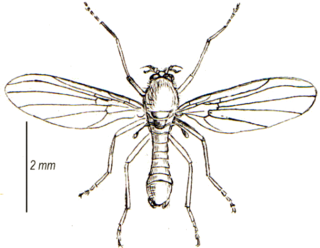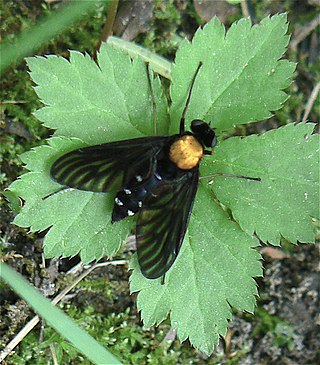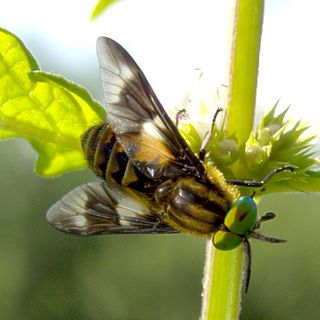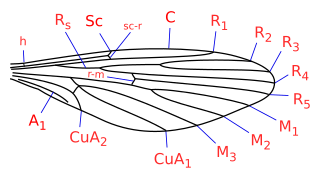
Paragus is a genus of hoverflies.

Thaumaleidae, the solitary midges or trickle midges, are a group of nematoceran flies related to the Ceratopogonidae, Chironomidae, and the Simuliidae. They are small, stocky, yellow to brown flies (3–4 mm). Very few species are known for this family. Larvae are found in films on rocks and the nonfeeding adults are usually found on foliage along the same streams in which the larvae are found. A few solitary midges are found in the Southern Hemisphere, but Thaumaleidae are generally an Holarctic family.

The Brachyceran family Vermileonidae is a small family of uncertain affinities and unusual biology. It includes fewer than 80 described species, most of them rare and with restricted distribution, in 10 genera. Historically the vermileonids had been regarded as belonging to the family Rhagionidae, possibly in a subfamily Vermileoninae. Their biology and morphology are so markedly distinct from the main Rhagionidae sensu stricto however, that the placement as a separate family has been widely accepted.

Chrysopilus is common, worldwide genus of predatory snipe flies. There are approximately 300 species in the genus, including fossil members that are sometimes found in amber.

The Lauxaniidae are a family of acalyptrate flies. They generally are small flies with large compound eyes that often are brightly coloured in life, sometimes with characteristic horizontal stripes, such as in Cestrotus species. Many species have variegated patterns on their wings, but in contrast they generally do not have variegated bodies, except for genera such as Cestrotus, whose camouflage mimics lichens or the texture of granitic rocks.

Superfamily Tabanoidea are insects in the order Diptera.

Athericidae is a small family of flies known as water snipe flies or ibis flies. They used to be placed in the family Rhagionidae, but were removed by Stuckenberg in 1973. They are now known to be more closely related to Tabanidae. Species of Athericidae are found worldwide.
Arthroteles is a genus of snipe fly of the family Rhagionidae. Species of Arthroteles are moderately sized, from 5 to 7.5 mm. They are gray to dark gray in colour. Their antenna bears seven to eight tapering flagellomeres, the first much larger than all others.
Parapachycerina is a genus of small African flies of the family Lauxaniidae. They are mostly yellow-orange in colour.

Nemopalpus is a genus of moth fly in the family Psychodidae, in the subfamily Bruchomyiinae. Nemopalpus is sometimes spelled "Nemapalpus" and recently (2018) a number of similar species have been transferred to the genera: Alexanderia, Boreofairchildia, Laurenceomyia and Notofairchildia.
Boreofairchildia is a genus of moth flies in the subfamily Bruchomyiinae. Species have been recorded from the Americas, principally Central and South America, with many, including the type, transferred from the genus Nemopalpus.

The subfamily Bruchomyiinae contains genera of moth flies in the order Diptera, was originally described by the American entomologist Charles Paul Alexander.
Laurenceomyia is a genus of moth flies in the subfamily Bruchomyiinae. Species have been recorded principally from south America, with many, including the type, transferred from the genus Nemopalpus.
Alhajarmyia is a genus of wormlion in the family Vermileonidae.
Vermipardus is a genus of wormlion in the family Vermileonidae.
Isalomyia is a genus of wormlion in the family Vermileonidae.
Vermilynx is a genus of wormlion in the family Vermileonidae.
Leptynoma is a genus of wormlion in the family Vermileonidae.
Lampromyia is a genus of wormlion in the family Vermileonidae.
Suraginella is a genus of flies in the family Athericidae.








